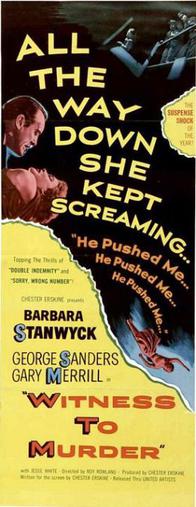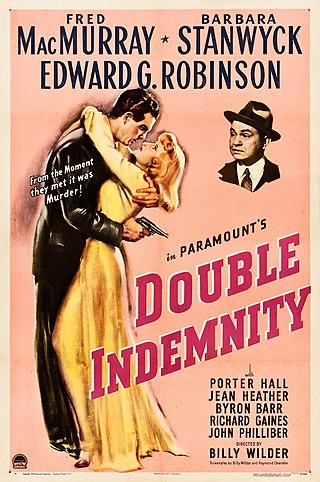
Double Indemnity is a 1944 American crime thriller film noir directed by Billy Wilder, co-written by Wilder and Raymond Chandler, and produced by Buddy DeSylva and Joseph Sistrom. The screenplay was based on James M. Cain's 1943 novel of the same title, which appeared as an eight-part serial for Liberty magazine in February 1936.

Sorry, Wrong Number is a 1948 American thriller and film noir directed by Anatole Litvak, from a screenplay by Lucille Fletcher, based on her 1943 radio play of the same name.

In the early hours of March 13, 1964, Kitty Genovese, a 28-year-old bartender, was raped and stabbed outside the apartment building where she lived in the Kew Gardens neighborhood of Queens in New York City, New York, United States. Two weeks after the murder, The New York Times published an article erroneously claiming that 38 witnesses saw or heard the attack, and that none of them called the police or came to her aid.
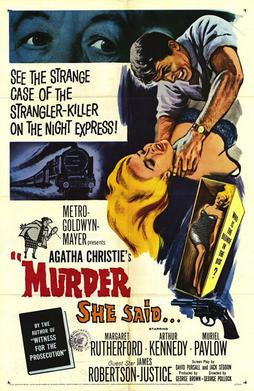
Murder, She said is a 1961 comedy/murder mystery film directed by George Pollock, based on the 1957 novel 4.50 from Paddington by Agatha Christie. The production stars Margaret Rutherford as Miss Marple, along with Arthur Kennedy, Muriel Pavlow, James Robertson Justice, and Stringer Davis.
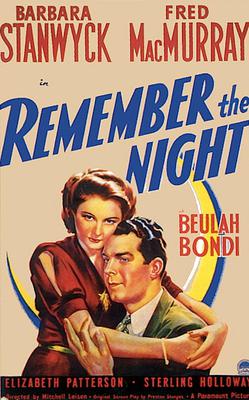
Remember the Night is a 1940 American Christmas romantic comedy trial film starring Barbara Stanwyck and Fred MacMurray and directed by Mitchell Leisen. The film was written by Preston Sturges and was the last of his scripts shot by another director, as Sturges began his own directorial career the same year with The Great McGinty.
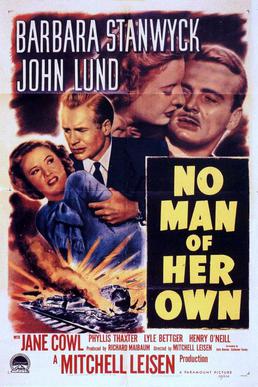
No Man of Her Own is a 1950 American film noir drama directed by Mitchell Leisen and featuring Barbara Stanwyck, John Lund, Phyllis Thaxter, Jane Cowl and Lyle Bettger. The production is the second film Stanwyck made with director Mitchell Leisen. Its screenplay was adapted from Cornell Woolrich's 1948 novel I Married a Dead Man. Woolrich is cited in the film's opening credits by one of his commonly used pseudonyms, "William Irish".

The Saint Takes Over, released in 1940 by RKO Pictures, was the fifth of eight films in RKO's film series about Simon Templar, also known as "The Saint", the Robin Hood-inspired crimefighter created by Leslie Charteris. George Sanders played Templar for the fourth time. Sanders made one more Saint picture the following year. Wendy Barrie played his latest romantic interest, in her second of three appearances in the Saint film series.

Theresa Jimmie Francine Knorr is an American woman convicted of torturing and murdering two of her six children while using the others to facilitate and cover up her crimes. She was acquitted of murdering her first husband and was also considered a suspect in the unsolved murder of her sister. She is currently serving two consecutive life sentences at the California Institution for Women in Chino, California.

The Woman in Red is a 1935 American drama film directed by Robert Florey and starring Barbara Stanwyck and Gene Raymond. Based on the novel North Shore by Wallace Irwin, the film is about a woman equestrian who meets and falls in love with a traveling polo player from a once wealthy family. After they are married, she is persuaded to entertain her friend's wealthy client aboard a yacht. The client accidentally drowns, and her friend is arrested for his murder. Determined to keep her name out of the press, the friend does not reveal that he has a witness who can prove his innocence.

The Mad Miss Manton is a 1938 American screwball comedy-mystery film directed by Leigh Jason and starring Barbara Stanwyck as fun-loving socialite Melsa Manton and Henry Fonda as newspaper editor Peter Ames. Melsa and her debutante friends hunt for a murderer while eating bonbons, flirting with Ames, and otherwise behaving like irresponsible socialites. Ames is also after the murderer, as well as Melsa's hand in marriage.

Crime of Passion is a 1957 American film noir crime drama directed by Gerd Oswald and written by Jo Eisinger. The cast features Barbara Stanwyck, Sterling Hayden and Raymond Burr.

The Locked Door is a 1929 American pre-Code drama film directed by George Fitzmaurice, and starring Rod LaRocque, Barbara Stanwyck, William "Stage" Boyd and Betty Bronson. It is based on the 1919 play The Sign on the Door by Channing Pollock. The play was first adapted for the screen in 1921 as The Sign on the Door, starring Norma Talmadge. It was Stanwyck's first starring role and first talking film.

Apartment 1303 (1303号室) is a Japanese horror film, directed by Ataru Oikawa, that revolves around a woman who investigates a series of suicides in her late sister's apartment. Based on Ju-on horror author Kei Ōishi's original novel.
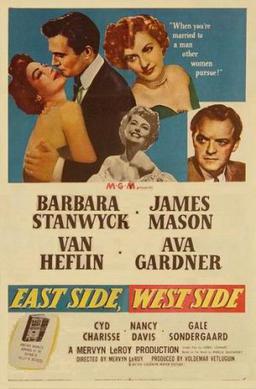
East Side, West Side is a 1949 American melodrama crime film, starring Barbara Stanwyck, James Mason, Van Heflin, and Ava Gardner. Based on the 1947 novel of the same title, written by Marcia Davenport, screenplay by Isobel Lennart, produced by Voldemar Vetluguin, directed by Mervyn LeRoy, and distributed by Metro-Goldwyn-Mayer.

Opened by Mistake is a 1940 film starring Charlie Ruggles and Janice Logan.

The Falcon Takes Over, is a 1942 black-and-white mystery film directed by Irving Reis. The B film was the third, following The Gay Falcon and A Date with the Falcon (1941), to star George Sanders as the character Gay Lawrence, a gentleman detective known by the sobriquet the Falcon.
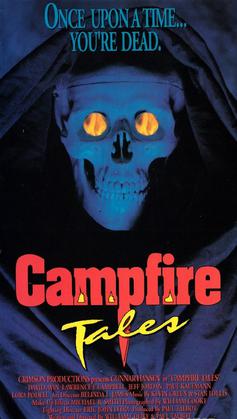
Campfire Tales is a 1991 American anthology horror film written and directed by William Cooke and Paul Talbot. The film is about a group of teenagers telling ghost stories around a campfire. One of the storytellers is horror legend Gunnar Hansen. The movie also uses many elements from famous horror stories and directors.

Rodney James Alcala was an American serial killer and sex offender who was sentenced to death in California for five murders committed between 1977 and 1979, receiving an additional sentence of 25 years to life after pleading guilty to two further homicides committed in New York State in 1971 and 1977. While he has been conclusively linked to eight murders, Alcala's true number of victims remains unknown and could be much higher – authorities believe the actual number is as high as 130.

The Night Walker is a 1964 American psychological horror film directed and produced by William Castle, written by Robert Bloch, and starring Robert Taylor, Judith Meredith, Lloyd Bochner and Barbara Stanwyck in her final film role. It follows the wife of a wealthy inventor who is plagued by increasingly disturbing nightmares, which escalate after her husband's death. It was the final black and white film made by Universal Pictures.
Laurie Show was a 16-year-old sophomore at Conestoga Valley High School who was stalked by her classmates and murdered on December 20, 1991, in the United States. Her body was discovered in her Lancaster, Pennsylvania home by her mother Hazel Show with her throat having been slit. Her classmates Lisa Michelle Lambert, Tabitha Buck, and Lawrence "Butch" Yunkin were all subsequently charged with her murder.
